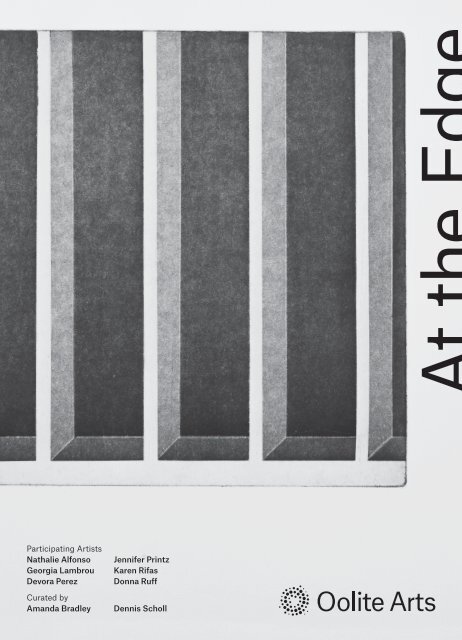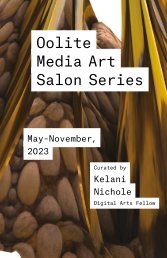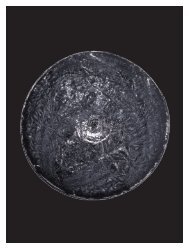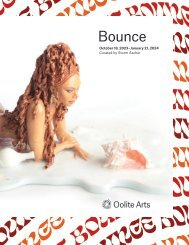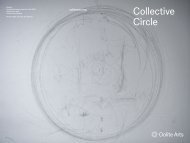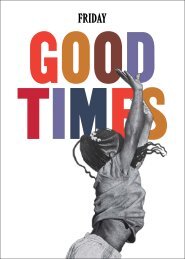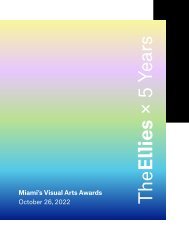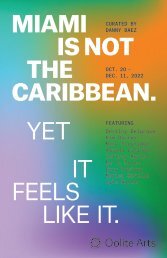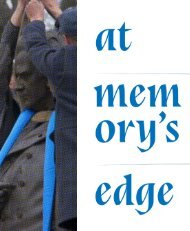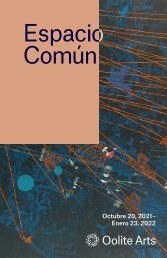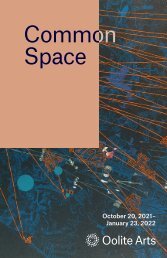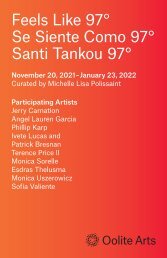You also want an ePaper? Increase the reach of your titles
YUMPU automatically turns print PDFs into web optimized ePapers that Google loves.
Participating Artists<br />
Nathalie Alfonso<br />
Georgia Lambrou<br />
Devora Perez<br />
Curated by<br />
Amanda Bradley<br />
Jennifer Printz<br />
Karen Rifas<br />
Donna Ruff<br />
Dennis Scholl
<strong>At</strong> <strong>the</strong> <strong>Edge</strong><br />
June 8 – September 11, 2022<br />
Cover: Nathalie Alfonso. Anatomy I, 2019. Aquatint<br />
Print. 14 in x 16 in. Courtesy of <strong>the</strong> artist.<br />
<strong>At</strong> <strong>the</strong> <strong>Edge</strong> is an exhibition of women artists<br />
using hard-edge abstraction as a means to<br />
investigate and challenge <strong>the</strong> boundaries<br />
of material, process, and environment. Their<br />
approaches to abstraction derive from interdisciplinary<br />
practices that span both two- and<br />
three-dimensional space. While removing<br />
formal ties to nature, <strong>the</strong>se works — centered<br />
around line, form, and color — offer room for<br />
a deep well of meaning and varying readings<br />
to emerge. The gallery becomes a site for<br />
assembling this multiplicity that abstraction<br />
provides. Drawing from notions of labor, resistance,<br />
and transformation, <strong>the</strong> works in <strong>the</strong><br />
exhibition survey abstraction as a space that<br />
lies at <strong>the</strong> edge.<br />
When we stand at <strong>the</strong> edge, we stand amid a<br />
multitude of opportunities, positioned between<br />
where we came from and where we might go<br />
next. This is a fertile location and point of view.<br />
Similarly, <strong>the</strong> space between representation<br />
and abstraction is a rich mine for meaning,<br />
removing preconceived notions and ideas, and<br />
loosening <strong>the</strong> mind to explore and expand.<br />
For Georgia Lambrou, <strong>the</strong> explorations in<br />
abstraction stem from an interest in <strong>the</strong> built<br />
world, <strong>the</strong> spaces and structures that we<br />
navigate and exist within in our daily lives that<br />
shape our relationships. As Gaston Bachelard<br />
wrote in The Poetics of Space, “A house that has<br />
been experienced is not an inert box. Inhabited<br />
space transcends geometrical space.” 1<br />
Also directly responding to physical space,<br />
Nathalie Alfonso explores abstraction as a<br />
method of repetition and endurance, this process<br />
playing a crucial role in <strong>the</strong> creation of<br />
her works. Built from <strong>the</strong> relationship she<br />
develops with each space in which she works,<br />
<strong>the</strong> investment of time and her bodily presence<br />
is demarcated through her use of materials —<br />
primarily charcoal and graphite — which record<br />
<strong>the</strong> labor of <strong>the</strong> hand and oils from her fingertips.<br />
In Devora Perez’s practice, abstraction allows<br />
a blurring of dimensions to occur as her work<br />
operates in <strong>the</strong> spaces between painting,<br />
sculpture, and installation. Although minimal,<br />
and subtle in form, her three-dimensional floor<br />
works disrupt ideas of structure, utility, and<br />
definition. She creates works that serve as a<br />
form of resistance, pushing beyond any singular<br />
limitation, with interactions between space,<br />
material, and light adding layers of meaning.<br />
Language and communication are starting<br />
points for Donna Ruff. Using newspapers<br />
as both linguistic content and source of material,<br />
she cuts away sections and abstracts original<br />
messages, <strong>the</strong> geometric motifs of <strong>the</strong> handcut<br />
pieces signifying, in her own words, “a sense<br />
of loss and time passing in abstract terms — as<br />
fragmentations of shape and pattern.”<br />
Jennifer Printz uses abstraction as a<br />
parallel to poetry, her works often gesturing at<br />
a loose narrative that allows for many meanings<br />
to take shape. A sense of instinct and freedom<br />
guides <strong>the</strong> decision-making process of her<br />
work, which often becomes a meditative place<br />
of making. Ambiguous forms found in nature<br />
are referenced, denoting places where <strong>the</strong> natural<br />
world exists as undefined and abstract.<br />
Lastly, <strong>the</strong> work of Karen Rifas is both monumental<br />
and delicate. The formal qualities of<br />
her work — bold colors, shapes, and lines — truly<br />
embody what abstraction is and may still<br />
become, with endless possibilities and abundant<br />
ground for developing meaning. Rifas’s<br />
exploration of color over <strong>the</strong> last decade is<br />
informed by her experience as a dancer and<br />
ties to Miami, with its tropical palette.<br />
Working at <strong>the</strong> edges, with all of <strong>the</strong> challenges<br />
and possibilities that embodies, each of <strong>the</strong><br />
exhibiting artists eschews <strong>the</strong> gestural form,<br />
choosing instead to embrace abrupt transitions<br />
between materials, mark-making, and fields of<br />
color. Toge<strong>the</strong>r, <strong>the</strong>ir works interrogate assumptions<br />
about geometric abstraction, its conventional<br />
methods and formal beauty, and instead<br />
pose salient new questions about <strong>the</strong> edges we<br />
all find ourselves poised upon today.<br />
1 Gaston Bachelard, The Poetics of Space, 1957<br />
(Boston: Beacon Press, 1994), 47.
<strong>At</strong> <strong>the</strong> <strong>Edge</strong> es una exposición de mujeres artistas<br />
que utilizan la abstracción de la pintura hardedge<br />
(borde duro) como medio para investigar y<br />
desafiar los límites del material, del proceso y del<br />
entorno. Su enfoque de la abstracción se deriva<br />
de prácticas interdisciplinarias que abarcan<br />
tanto el espacio bidimensional como el tridimensional.<br />
Al mismo tiempo que eliminan los<br />
vínculos formales con la naturaleza, estas obras<br />
— centradas en la línea, la forma y el color —<br />
ofrecen espacio para que surja un profundo pozo<br />
de significado y diversas lecturas. La galería<br />
se convierte en un lugar para ensamblar esta<br />
multiplicidad que proporciona la abstracción.<br />
Partiendo de las nociones de trabajo, resistencia<br />
y transformación, las obras de la exposición<br />
examinan la abstracción como un espacio que se<br />
encuentra en el límite.<br />
Cuando nos situamos en el límite, nos encontramos<br />
en medio de una multitud de oportunidades,<br />
ubicados entre el lugar de donde venimos<br />
y el lugar al que podríamos ir después. Este es<br />
un lugar y un punto de vista fértil. Del mismo<br />
modo, el espacio entre la representación y la<br />
abstracción es una rica mina de significados,<br />
que elimina las nociones e ideas preconcebidas<br />
y libera la mente para explorar y expandirse.<br />
Para Georgia Lambrou, las exploraciones de la<br />
abstracción surgen de un interés por el mundo<br />
construido: los espacios y estructuras por<br />
los que navegamos y en los que existimos en<br />
nuestra vida diaria y que dan forma a nuestras<br />
relaciones. Como escribió Gaston Bachelard en<br />
La poética del espacio, “Una casa vivida no es<br />
una caja inerte. El espacio habitado trasciende<br />
el espacio geométrico”.<br />
También respondiendo directamente al espacio<br />
físico, Nathalie Alfonso explora la abstracción<br />
como método de repetición y resistencia,<br />
jugando este proceso un papel crucial en la<br />
creación de sus obras. Construida a partir de la<br />
relación que desarrolla con cada espacio en el<br />
que trabaja, la inversión de tiempo y su presencia<br />
corporal se demarca a través de su uso de<br />
materiales — principalmente carbón y grafito<br />
— que registran el trabajo de la mano y el aceite<br />
de las yemas de sus dedos.<br />
En la práctica de Devora Pérez, la abstracción<br />
permite que se produzca una difuminación<br />
de las dimensiones, ya que su obra opera en<br />
el espacio entre la pintura, la escultura y la<br />
instalación. Aunque son mínimas y sutiles<br />
en su forma, sus obras tridimensionales en el<br />
suelo alteran las ideas de estructura, utilidad y<br />
definición. Crea obras que sirven como forma<br />
de resistencia, superando cualquier limitación<br />
particular, con interacciones entre el espacio,<br />
el material y la luz que añaden capas de<br />
significado.<br />
El lenguaje y la comunicación son puntos de<br />
partida para Donna Ruff. Utilizando los<br />
periódicos como contenido lingüístico y fuente<br />
de material, recorta secciones y abstrae los<br />
mensajes originales; los motivos geométricos<br />
de las piezas cortadas a mano significan, en sus<br />
propias palabras, “una sensación de pérdida y<br />
de paso del tiempo en términos abstractos,<br />
como fragmentaciones de la forma y el patrón”.<br />
Jennifer Printz utiliza la abstracción como<br />
paralelo a la poesía, y sus obras a menudo<br />
apuntan a una narrativa suelta que permite que<br />
tomen forma muchos significados. Un sentido<br />
de instinto y libertad guía el proceso de toma<br />
de decisiones de su obra, que a menudo se<br />
convierte en un lugar de meditación. Se hace<br />
referencia a formas ambiguas de la naturaleza,<br />
que denotan lugares en los que el mundo natural<br />
existe de forma indefinida y abstracta.<br />
Por último, la obra de Karen Rifas es a la vez<br />
monumental y delicada. Las cualidades formales<br />
de su obra — colores vivos, formas y líneas —<br />
encarnan realmente lo que la abstracción es y<br />
puede llegar a ser, con infinitas posibilidades<br />
y abundante terreno para desarrollar el significado.<br />
La exploración del color por parte de Rifas<br />
en la última década se debe a su experiencia<br />
como bailarina y a sus vínculos con Miami, con<br />
su paleta tropical.<br />
Trabajando en los límites, con todos los retos y<br />
posibilidades que ello conlleva, cada uno de los<br />
artistas expuestos evita la forma gestual, eligiendo<br />
en su lugar abrazar transiciones abruptas<br />
entre materiales, marcas y campos de color. En<br />
conjunto, sus obras cuestionan las suposiciones<br />
sobre la abstracción geométrica, sus métodos<br />
convencionales y su belleza formal, y en su lugar<br />
plantean nuevas y notorias preguntas sobre los<br />
bordes en los que nos encontramos hoy en día.<br />
1 Gaston Bachelard, The Poetics of Space, 1957<br />
(Boston: Beacon Press, 1994), 47.
Karen Rifas, 1610, 2020. Acrylic on paper, 96in × 96 in.<br />
Courtesy of Emerson Dorsch Gallery<br />
Devora Perez, Chroma in Situ, 2022.<br />
Maple wood, colored acrylic sheet,<br />
Dimensions variable.<br />
Karen Rifas, 3928, 2020. A<br />
paper, 23in × 25in. Courtes
Donna Ruff, After Irma, 2017.<br />
Archival on kozo paper from<br />
photogram, 38 ½ × 27 in.<br />
Courtesy of Rick Wester Fine Art<br />
crylic on Arches Hot Pressed 140lb Watercolor<br />
y of Emerson Dorsch Gallery<br />
Donna Ruff, Division, 2018. Archival print on kozo paper from<br />
photogram, 31 ½ × 23 ½ in. Courtesy of Rick Wester Fine Art
Nathalie Alfonso, Anatomy V-Grid, 2019.<br />
Aquatint, 14 × 16 in. each. Courtesy of <strong>the</strong> artist<br />
Jennifer Printz, Tracing The Mysteries i, 2021. Relief<br />
print with chine colle (epson ultrachrome inks on<br />
washi), 15 × 22 in. Courtesy of <strong>the</strong> artist
Georgia Papadavid Lambrou, Intersection I, 2002.<br />
Ink Drawing on Vellum, 11 × 14 in. Courtesy of<br />
Georgia Lambrou Art<br />
Georgia Papadavid Lambrou, (in clockwise order from top left)<br />
Charrette, 2022; Enclosure, 2022; Threshold, 2022; Deviation,<br />
2022; Basswood, Acrylic & Watercolor on Wood Panel and Linen<br />
Base, 17 × 17 × 2 in. Courtesy of Georgia Lambrou Art
924 Lincoln Road<br />
Miami Beach, FL 33139<br />
Tag us: @OoliteArts • #OoliteArts<br />
OoliteArts.org<br />
Staff<br />
Dennis Scholl<br />
President and CEO<br />
Anais Alvarez<br />
Communications & Development Sr. Manager<br />
Danielle Bender<br />
Cinematic Arts Manager<br />
Amanda Bradley<br />
Programming Sr. Manager<br />
David Correa<br />
Programs Coordinator<br />
Cherese Crockett<br />
Development Sr. Manager<br />
Maylin Enamorado-Pinheiro<br />
Digital Communications Coordinator<br />
Aaron Feinberg<br />
Chief Financial Officer<br />
Melissa Gabriel<br />
Art Classes Manager<br />
Samantha Ganter<br />
Programs Coordinator<br />
Juan Matos<br />
Digital Content Producer & Coordinator<br />
Es<strong>the</strong>r Park<br />
Vice President of Programming<br />
Dan Weitendorf<br />
Facilities Manager<br />
Board of Directors<br />
Eric Rodriguez<br />
Chair<br />
Marie Elena Angulo<br />
Vice Chair<br />
Donnamarie Baptiste<br />
Secretary<br />
Kim Kovel<br />
Chair Emeritus<br />
Chloe Berkowitz<br />
Alessandro Ferretti<br />
Lilia Garcia<br />
Jane Goodman<br />
Adler Guerrier<br />
Thomas F. Knapp<br />
Jeff Krinsky<br />
Lin Lougheed<br />
Maricarmen Martinez<br />
Reagan Pace<br />
Deborah Slott<br />
Copy Editor<br />
John Ewing<br />
Translation<br />
Sergio Doré<br />
Exhibitions and programs at Oolite Arts are made possible with support from <strong>the</strong> Miami-Dade County Department of Cultural<br />
Affairs, <strong>the</strong> Cultural Affairs Council, <strong>the</strong> Miami-Dade Mayor and Board of County Commissioners; <strong>the</strong> City of Miami Beach<br />
Cultural Arts Council; <strong>the</strong> Miami Beach Mayor and City Commissioners; <strong>the</strong> State of Florida, Florida Department of State,<br />
Division of Arts & Culture, <strong>the</strong> Florida Arts Council; <strong>the</strong> National Endowment for <strong>the</strong> Arts; <strong>the</strong> Lynn & Louis Wolfson II Family<br />
Foundation, The Jorge M. Pérez Family Foundation at The Miami Foundation; <strong>the</strong> Al & Jane Nahmad Family Foundation; and <strong>the</strong><br />
John S. and James L. Knight Foundation. Additional support provided by Walgreens Company.


